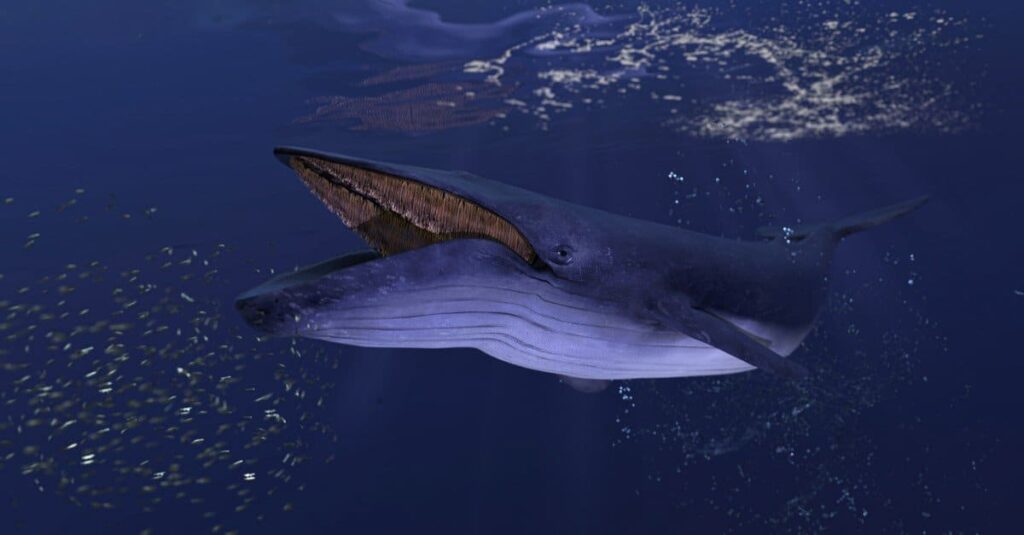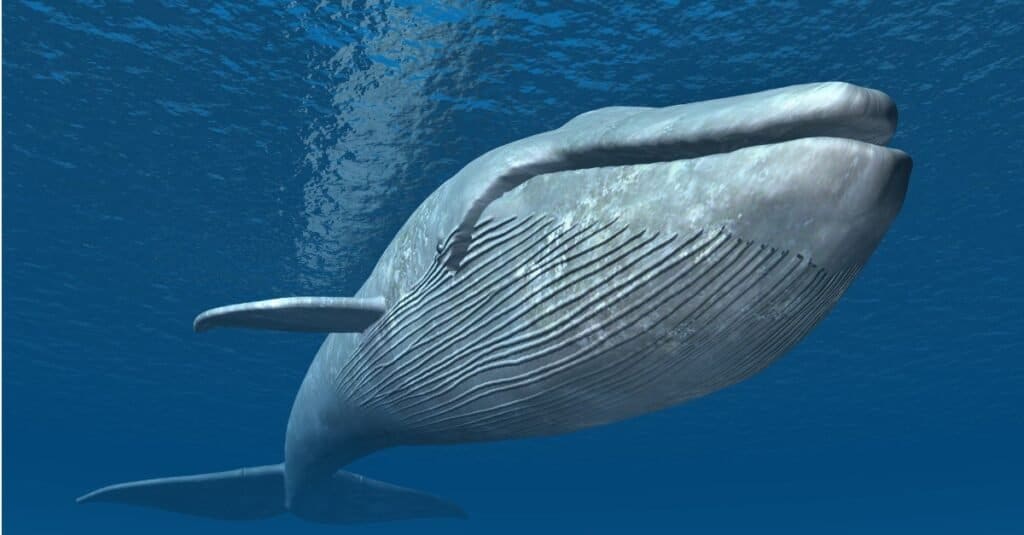Blue whales make intense and beautiful vocalizations under the water. We’ve been aware of this for many years, but it’s not as simple as Dory from Finding Nemo makes it out to be. You can’t just sing your words in alternating pitches to get across what you mean. Blue whales have distinctive sounds that represent very specific things.
These sounds have a few different variations on them, which leads to them meaning other things. We will explore this further in the article.
What is a Blue Whale?

Blue whales are the largest mammals on earth.
©Maria Spb/Shutterstock.com
Blue whales, or baleen whales, are what you picture when you hear the word whale. They are long and asymmetrical with cavernous chests and mouths. The blue whale is the largest known animal to have ever existed and is still around today.
The blue whale is a mammal, giving birth to live young, carrying them to term, and feeding them milk. Mothers bond with their young until they are weaned and are usually more solitary. Some swim in small pods.
Blue whales can grow up to 100 feet in length, though anything over that is generally considered an inaccurate measurement. Their weight does not exceed 190 tons, which is 380,000 pounds.
Imagine how large you think that is, then imagine again. The size of this species is almost astronomical compared to humans and the animals we encounter each and every day.
Are Blue Whales Endangered?

Blue whales are an endangered species.
©bekirevren/Shutterstock.com
Most people don’t know that blue whales are actually endangered. Due to overfishing and harvesting as a sport in the late 1800s, their populations declined. In the years 1930-1933, almost 30,000 blue whales were killed. That began a colossal onslaught of targeted hunting of these gentle giants.
At the beginning of the 1900s, there were an estimated 140,000 adult blue whales, compared to today’s estimation of around 15,000 adults. We can see how the populations have declined, giving the blue whale its endangered status.
What Do Blue Whales Sound Like?

Blue whales sound ethereal with their quick patterns of whines and wails.
©iStock.com/MR1805
The sound a blue whale makes is unique and diaphanous. A study in The Journal of the Acoustical Society of America classifies blue whale sounds as both tonal and non-tonal.
The idea is that an organ within the blue whale produces the sound. Then it is filtered through the giant body of the whale and comes out in the varying frequencies that we hear.
See this video to hear the beautiful sounds of the blue whale. It starts as a fast pulsing pattern, then turns into this soft, lucid wail that sounds almost playful. It’s like a long call or howl and is unlike anything else you’d hear.
The sounds blue whales make are so beautiful and ethereal, they draw you into the moment. Each vocalization presents itself slightly differently. There are quick pulsations that they start out with. Then they can become more flippant and tactile, touching the ear in different ways. The fact that we can now record them is exceptional.
What Do Blue Whale Sounds Mean

Blue whale sounds are meant to communicate their emotions and needs to other blue whales.
©Atomic Roderick/Shutterstock.com
The sounds and whistles of a blue whale mean different things depending on their goals. An article in the Royal Society Open Science says, “Acoustic communication is an important aspect of reproductive, foraging, and social behaviors for many marine species.”
Basically, this translates to saying that they use the sounds they make to help find food, find mates, and communicate with other whales across the sea.
The article classifies calls as A, B, and D. A and B often form full songs performed by the blue whales, though they can be their own calls alone too. The article also says that most of the sounds heard can be attributed to female whales, though 40% were of unknown gender.
Single songs were more often during the day, while dual-frequency songs were performed in the evening. Mostly it seemed they produced these sounds in the fall.
Blue whales sing and moan when sad, producing beautiful songs to convey their emotions. They can be expressing sadness or joy or conveying danger to other whales. What they are saying is lost to the ocean, but we do the best we can to interpret them.
The photo featured at the top of this post is © Atomic Roderick/Shutterstock.com
Thank you for reading! Have some feedback for us? Contact the AZ Animals editorial team.







